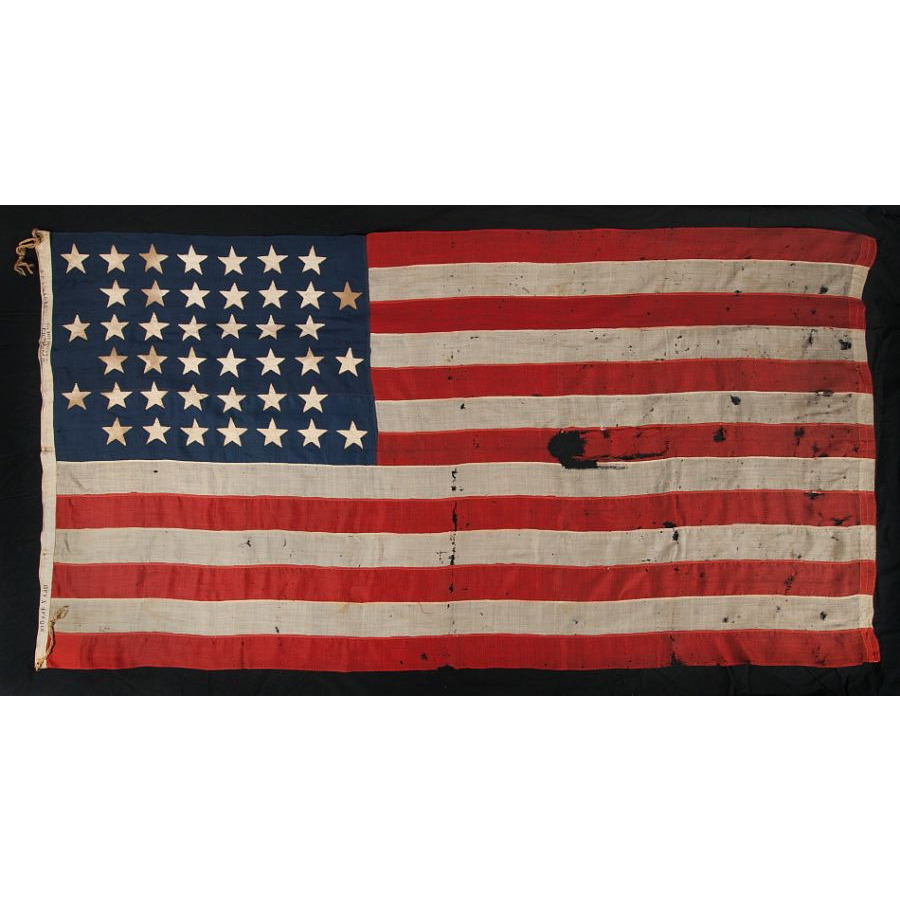
| |
42 STARS ARRANGED IN A RARE VARIATION OF A NOTCHED DESIGN, WITH SPACES FOR 3 MORE STARS ON BOTH THE HOIST AND FLY ENDS, AN UNOFFICIAL STAR COUNT, WASHINGTON STATEHOOD, 1889-1890, SIGNED "J. & F.A. WAGNER, MAKER," CLEVELAND, OHIO |
|
| Available: |
Sold |
| Frame Size (H x L): |
|
| Flag Size (H x L): |
49" x 91" |
|
| Description....: |
|
42 star American national flag, made by J. & F.A. Wagner in Cleveland, Ohio between 1889 and 1890. Along the hoist of the flag is maker’s stencil that lists their address as "No. 167 River St.". Makers’ marks are extremely scarce in 19th century flags. This is the only flag I have encountered from this manufacturer and while I was unable to find any meaningful information about the firm, they are documented as having been at the above address in the "Sixth Annual Report of the Department of Inspection of Workshops and Factories, to the General Assembly of the State of Ohio for the Year 1889," one of the two years in which this flag was likely produced.
The 42 star flag is interesting from a historical perspective, both because 42 was never an official star count, and because 42 star flags were only produced for about 8 months (November, 1889 – July 4th, 1890). The flag represents the addition of the Dakotas, Montana and Washington State, between November 2nd and November 11th, 1889. The 42nd state was officially Washington, but the four states gained their statehood only nine days apart and flag makers added four stars, accordingly, to the 38 star flag that was previously official.
After 1818, star counts became official on the 4th of July each year. A new star was therefore officially added on Independence Day for every state that had been added over the preceding “flag year”. Flag makers, however, did not wait for Independence Day and “official” star counts. Flag making was a competitive industry, and no one wanted to be making 38 star flags, for example, when their competitors were making 42 star flags and there were 42 states. On many occasions, particularly in the last quarter of the 19th century and the first decade of the 20th century, flag-makers would speculate the number of states that were going to be added and add the stars before they were official. It was for this precise reason that 42 was never an official star count. Idaho received statehood on July 3rd, 1890, taking the star count to 43 just one day before 42 would have become the official number. This fact makes 42 star flags an interesting part of our heritage and a classic display of American capitalism.
Despite their unusual story, printed 42 star flags (called parade flags or handwavers) are quite common. Many were made because flag makers were so excited to offer something new after 13 years with no reason to produce new star counts. But 42 star flags with pieced and sewn construction, like this one, are scarce. Why this is true is unclear.
The stars of the flag are arranged in what is known as a "notched" pattern, in which spaces have intentionally been left open for more stars representing states that had yet to be added. Two things are especially noteworthy in this particular notched design. One, the layout is especially attractive, and two, I do not ever recall seeing a notched pattern on another 42 star flag. The count of 6 "notches" reflects the fact that the number of Western Territories that had yet to become states was known, at least to this flag-maker. Borders within the territories were frequently a matter of contention and negotiation. The Dakota Territory, for example, split rather unexpectedly into two states when it finally entered the Union in 1889, immediately before the manufacture of this flag. Some flag-makers had been producing 39 star flags prior to this time, increasing the number by just 1 star instead of 2. For these reasons it seems clear that makers were not ready to presume that exactly 6 states remained outstanding.
Note how the proportions of the flag are rather elongated. This made it easier to extend the life of flag by turning back the fly end as it became damaged by wind shear. In addition to being practical, this format is especially attractive. When good graphics are added to scarce features, the result is a more desirable flag among collectors.
Construction: The canton and stripes of the flag are made of wool bunting that has been pieced with treadle stitching. The stars are made of cotton and are double-appliquéd (applied to both sides) with a lineal treadle stitch. There is a twill cotton binding along the hoist with two brass grommets. Black-inked stencils were applied along this with the maker's name and address, along with the measurements, which read "8 FT X 4 FT 2 IN."
Mounting: The flag has not yet been mounted. We employ professional staff with masters degrees in textile conservation and can attend to all of your mounting and framing needs.
Condition: There is minor to moderate mothing throughout, accompanied by a more significant area of loss in the center of the 4th red stripe. There is moderate soiling in a handful of the stars and minor foxing and staining elsewhere. All of the above can be masked during the mounting process. |
|
|
|
| Collector Level: |
Intermediate-Level Collectors and Special Gifts |
|
| Flag Type: |
Sewn flag |
|
| Star Count: |
42 |
|
| Earliest Date of Origin: |
1889 |
|
| Latest Date of Origin: |
1890 |
|
| State/Affiliation: |
Washington |
|
| War Association: |
1866-1890 Indian Wars |
|
| Price: |
SOLD |
|
| |
Views: 2673 |
|
|
|

